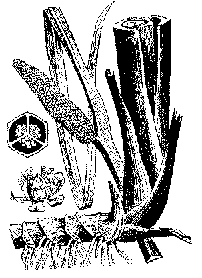| < | CALAMUS | > |
acorus calamus
| action | analgesic, anthelmintic, anticonvulsive, antidiarrheal, antihemorrhagic, antirheumatic, antiseptic, apertif, aphrodisiac, bitter, blood cleanser, carminative, cathartic, diaphoretic, digestive, diuretic, emetic, emmenagogue, expectorant, febrifuge, fumitory, hallucinogen, hemostat, laxative, mind alterant, nervine, panacea, pediculifuge, psychological aid, sedative, stimulant, stomach irritant, stomachic, tonic, venereal, vermifuge |
| body | eye |
| common name | calamus, grass myrtle, myrtle flag, rat root, sweet flag, sweet grass, sweet myrtle, sweet rush |
| contains | asarone, poison |
| family | acoraceae, araceae |
| indigenous use | appalachian, blackfoot, cherokee, cheyenne, chinese, chippewa, cree, dakota, danish, delaware, dutch, fox, french, german, iroquois, italian, menominee, menomini, meskwaski, micmac, mohegan, nanticoke, ojibwa, ojibwa, omaha, pawnee, ponca, potawatomi, rappahannock, santal, saulteau, shinnecock, sioux, spanish, winnebago |
| range | acadia national park, apostle islands national lakeshore, arabia, asia, bavaria, brazil, canada, cape cod national seashore, catoctin mountain park, china, cuyahoga valley national recreation area, egypt, george washington memorial parkway, great smoky mountains national park, harpers ferry national historic park, hopewell furnace national historic site, hungary, india, indiana dunes national lakeshore, iran, java, johnstone flood national memorial, malaya, malaysia, nepal, new guinea, petersburg national battlefield, pictured rocks national lakeshore, saint croix national scenic river, saratoga national historic park, shenandoah national park, sumatra, texas, us, voyageurs national park, yugoslavia |
| use | liqueur, medicine, mouthwash, snuff |
| used to treat | asthma, bronchitis, burns, cancer, catarrh, chest cold, children's ailments, colic, common cold, constipation, consumption, cough, diarrhea, dysentery, dyspepsia, ear ailments, epilepsy, fever, flatulence, gangrene, gastro-intestinal disturbances, headache, hemorrhage, kidney ailments, mouth ailments, nerves, odontosis, parturition, phthisis, pulmonary ailments, respiratory ailments, skin ailments, sore (throat), spasms, splenomegaly, stomach ache, stomach ailments, throat ailments, toothache, toothache, tuberculosis, urinary ailments |
| comments |
Roots are collected in late autumn or spring, washed, voided of root fibers and dried with moderate heat. Root may be chewed or broken up and boiled as a tea. Root deteriorates with age and is usually inactive after 1 year. Must be stored closed in cool dry place. A piece of dried root the thickness of a pencil and about 2 inches long provides stimulating and buoyant feelings. A piece 10 inches long is reported to act as a mind alterant and hallucinogen, but will more likely be violently emetic, especially when mixed with alcohol. The Cree of Northern Alberta chew calamus root for oral hygiene and as a stimulating tonic.
|
 |